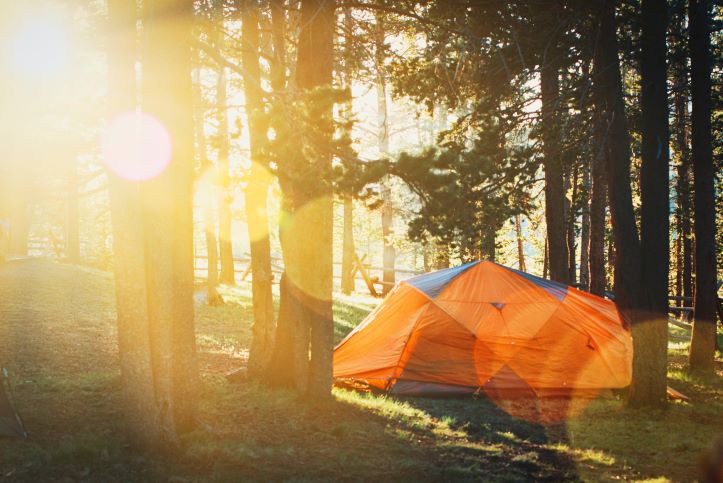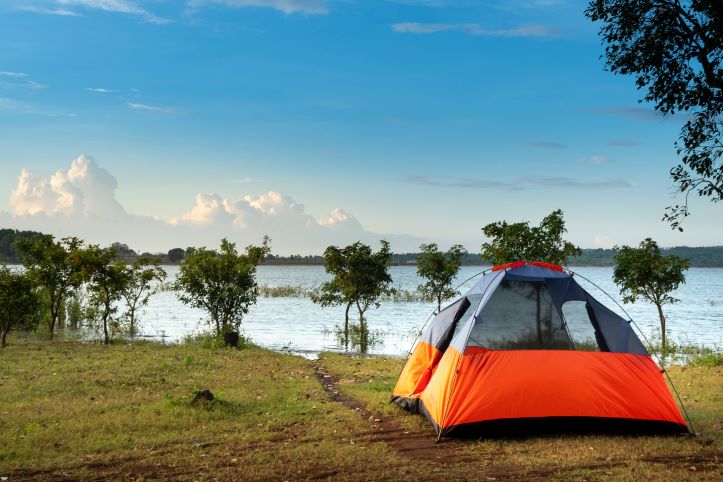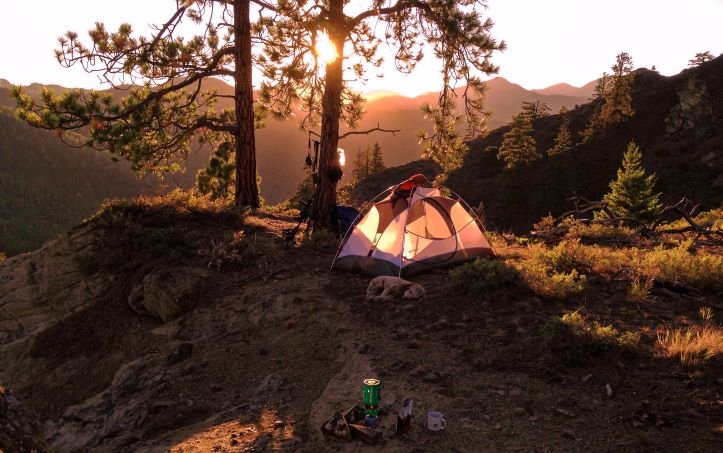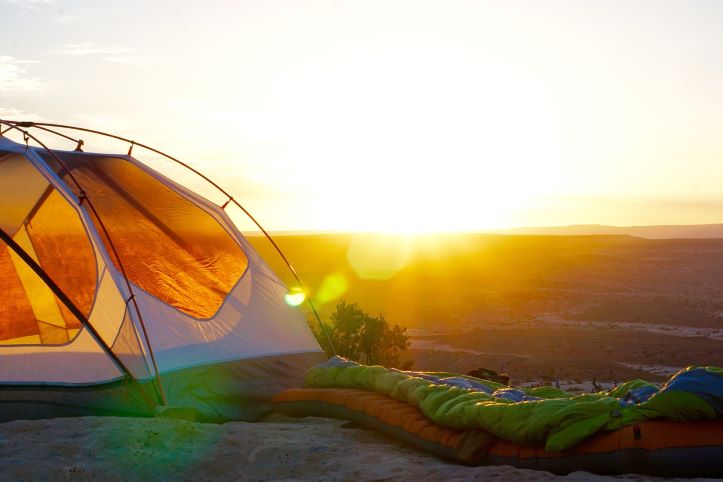To cool a tent without electricity, maximize ventilation and utilize reflective tarps. Choosing a shaded location can also reduce internal tent temperatures significantly.
Camping trips often bring the challenge of staying comfortable in various weather conditions, and managing heat inside a tent is a common hurdle. A sweltering tent can transform a restful retreat into an uncomfortably warm experience. Knowing how to cool a tent without electricity becomes essential to ensure your outdoor adventure remains enjoyable.
Without the luxury of electric fans or air conditioners, campers must rely on strategic placement, innovative accessories, and natural cooling methods. The key to a cool tent lies in understanding how to harness the environment and employ simple yet efficient techniques to create a more pleasant and cooler camping experience.
Introduction To Tent Cooling
As the sun beats down on your camping site, keeping cool becomes more than a comfort—it’s a necessity. While electricity-dependent air conditioners and fans are standard go-to solutions, they aren’t always an option in the great outdoors. Understanding non-electric cooling methods for tents is both a survival skill and a way to enhance your outdoor experience. Let’s dive into how you can stay chill on your next camping adventure without relying on power.
Tent insulation plays a vital role in maintaining the interior temperature. The fabric, color, and design of your tent can either trap heat or help cool it down. Optimizing these factors is your first step towards a cooler resting space.
- Reflective materials can deflect sunlight away from the tent.
- Breathable fabrics encourage air circulation, preventing heat accumulation.
- Using a flysheet or tarp provides an additional layer of insulation and shade.
Keeping a tent cool presents unique difficulties. Limited air flow and high outdoor temperatures can quickly turn your shelter into a sauna. Sun exposure, humidity, and the tent’s surrounding environment all influence the effectiveness of your cooling efforts.
| Challenge | Reasons | Impact |
| Sun exposure | Direct sunlight increases tent temperature | Reduced comfort, increased risk of overheating |
| Humidity | Traps heat and restricts air flow | Sticky, uncomfortable conditions |
| Air flow | May be limited by tent design and placement | Insufficient ventilation, increased interior heat |
With these challenges in mind, employing non-electric cooling techniques becomes most practical. These methods ensure sustainability and are often more adaptable to the diverse environments you may encounter while camping.
- They are environmentally friendly, reducing carbon footprint.
- They improve your connection with nature, allowing for a more authentic camping experience.
- They are cost-effective as they eliminate the need for powered equipment.
Natural Methods To Cool Your Tent
Welcome to the peaceful realm of camping where the beauty of the outdoors meets the rustic charm of a tent. However, as the mercury rises, so does the challenge of keeping your tent cool without relying on electric gadgets. Fear not, fellow campers, for there are time-tested, natural methods to maintain a comfortable temperature within your canvas abode. Let’s explore nature’s own cooling solutions that will help you beat the heat and enjoy a serene, refreshing camping experience.
Choosing The Right Location
The quest for a cool tent begins with selecting the perfect spot. Like real estate, location is everything. Aim for an area that benefits from natural cooling elements. Prioritize sites with ample tree cover or near bodies of water. These natural features will provide not only scenic views but also much-needed shade and cooler air throughout the day.
- Pick a shaded spot under trees that can shield your tent from direct sunlight.
- Choose a location where the ground is cool and covered with grass rather than sand or rock, which tends to retain heat.
- Proximity to water bodies can offer a cooler microclimate due to evaporative cooling.

Maximizing Natural Air Flow
To utilize the ambient breezes to your advantage, tent placement is crucial. Orient the tent so that its openings align with the wind’s direction. Opt for a tent with multiple openings – windows, doors, or vents – to create a cross breeze that will carry heat away.
Ensure these openings are equipped with mesh screens to keep bugs out while still letting air in. Circulation is key:
- Position the tent to catch the prevalent wind currents.
- Open all vents and position additional openings in the path of the wind for maximum airflow.
- Consider leaving the tent door open if safe and practical to boost air circulation.
Utilizing Shade Effectively
Nature’s canopy can be your ally in the battle against the oppressive heat. The strategic use of natural shade can substantially lower the temperature inside your tent.
Set up your tent so that it remains in the shadow during the hottest parts of the day. If natural shade is scarce, create your own with tarps or specialized camping canopies, which can be stretched over the tent or between trees.
- Ensure the tent is under shadow during the afternoon heat.
- Rig a reflective tarp above the tent to deflect sunlight.
- Use tarps or canopies to create shaded areas around your campsite for added relief.
The Impact Of Tent Color And Material
A tent is made of various materials. The choice of tent color and material plays a significant role in heat management. Light-colored tents are preferable as they reflect rather than absorb the sun’s rays. Breathable materials, like cotton canvas, also promote better air circulation compared to synthetic fabrics which can trap heat.
| Tent Color | Heat Absorption |
| Lighter Shades | Less Heat Absorption |
| Darker Shades | More Heat Absorption |
Choosing the right fabric and color will make a noticeable difference in cooling efficiency:
- Select a light-colored tent to reflect sunlight and keep the interior cool.
- Choose cotton canvas or poly-cotton blends for better breathability.
- Avoid dark colors and dense synthetic materials that can turn your tent into a sauna.
Enhancing Tent Ventilation
When the mercury soars, staying cool in a tent becomes an art form. Ventilation is key to regulating temperature and maintaining comfort during those sweltering days and nights in the great outdoors. It’s all about encouraging a gentle flow of air, which can drastically reduce the heat within your temporary canvas home. Let’s explore some effective strategies to create a breezy sanctuary without depending on electric gadgets.
Proper Tent Setup For Enhanced Air Circulation
Choosing the right spot to pitch your tent is the first step in maximizing air circulation. Aim for a shaded area, if available, to prevent the sun from turning your tent into a greenhouse.
Select a location with natural airflows, such as on a gentle slope or near water bodies, where breezes are more common. Orient the tent openings toward the prevailing wind to capture the natural breeze.
- Don’t setup the tent directly on the ground; instead, use a raised bed or cot to allow air to flow underneath.
- Ensure that all the ventilation flaps and roof vents are open to encourage upward airflow as the hot air rises.
Use Of External Wind Catchers
External wind catchers, like a strategically placed folding screen or tarp, can be a boon. They function as sails, guiding the breeze into your tent. Set them up to channel prevailing winds through the tent or to create a wind funnel that will carry the air through your camping abode.
| Wind Catcher Type | Positioning | Expected Benefit |
| Tarp | Angled towards wind | Directs airflow |
| Folding Screen | Perpendicular to tent opening | Creates a wind channel |
Create a makeshift wind scoop out of any spare fabric you have to guide the breeze into the tent, especially if natural wind is sparse.
Benefits Of Mesh Panels And Windows
Integrating mesh panels into your tent design is a brilliant move. They not only keep insects at bay but also promote air flow without compromising on shelter. During the night, when privacy is less of a concern, unzip the mesh windows to allow cooler air to circulate.
- Full-size mesh doors provide excellent cross-ventilation, particularly when positioned opposite each other.
- Positioning mesh windows on opposing sides ensures a consistent air current.
Be mindful of the sun’s position through the day; adjust the window openings to avoid direct sunlight while maintaining a steady stream of air.
Water-based Cooling Techniques
Beating the heat in the great outdoors can be a challenge, especially when you’re trying to enjoy a peaceful retreat in your tent. With no power supply to plug in a traditional air conditioner, you might wonder how to stay cool. Fear not, as water-based cooling techniques can be a tent’s best friend during those scorching summer camping trips. They’re simple, dependable, and don’t require any electricity. Let’s explore some innovative methods to keep your tent cool and comfortable utilizing the magic of water!
Evaporative Cooling With Wet Towels
Evaporative cooling is a fantastic way to reduce the temperature inside your tent. The process leverages the heat-absorbing properties of water to create a cooler environment. Here’s how to make the most of this natural phenomenon:
- Dampen towels or small blankets with water and hang them over the entrance or windows of your tent.
- Position them so the air flowing through them will evaporate the moisture and cool the interior space.
- Remember to rewet the towels periodically as they dry to maintain a consistent cooling effect.
Using Ice Or Cold Water Containers
Cold packs or containers filled with ice or cold water can also be useful in lowering your tent’s temperature:
| Method | Instructions | Expected Outcome |
| Ice Pack Placement | Position cold packs near the sleeping area for localized cooling. | Chill areas of the tent for immediate relief. |
| Ice Container | Place a large container of ice in the tent and allow it to slowly melt throughout the day. | Gradually decrease the overall temperature inside the tent. |
Misting Systems And Their Makeshift Alternatives
Even though conventional misting systems are typically electric, you can still enjoy a misting effect without power:
- Invest in a manual pump misting system that doesn’t require electricity or batteries.
- For a do-it-yourself approach, use a spray bottle filled with cold water and periodically mist the air inside your tent.
- The fine mist from these techniques will help cool the air as it evaporates on your skin and within the tent’s atmosphere.

Additional Tips And Tricks
Embarking on a camping adventure can often mean grappling with the blazing heat, especially in the absence of electricity for conventional cooling methods. Yet, fear not, as there are a slew of ingenious strategies to keep your tent cool and comfortable. From harnessing the reflective power of tarps to smartly timing your activities, these additional tips and tricks will help you become a savvy camper, fully prepared to beat the heat in the great outdoors.
Managing Tent Internal Temperature With Reflective Tarps
One simple trick to deflect sunlight and lower your tent’s temperature is to use reflective tarps. By draping a reflective tarp over your tent, you create a barrier that reflects the sun’s rays away, significantly reducing the heat that penetrates your shelter. Ensure the tarp is secured above the tent to allow for airflow and prevent heat buildup.
Effective Use Of Thermal Blankets
Thermal blankets, also known as space blankets, aren’t just for warmth; they can effectively block out heat as well. These lightweight and reflective blankets can be placed on the tent’s roof or used inside to reflect the sun. Additionally, they serve a dual purpose by keeping you warm during chilly nights. The key is positioning the blanket so that it reflects sunlight away during the day while retaining warmth after sundown.
Timing Your Activities To Cooler Parts Of The Day
Smart timing is crucial in avoiding the peak heat. Engage in strenuous activities such as hiking or fishing during early mornings or late afternoons when the temperature drops. This strategy not only conserves your energy but keeps the tent unoccupied during the hottest part of the day, reducing the heat that’s trapped inside.
Clothing And Sleep Gear Adjustments For Thermal Comfort
| Item | Adjustment for Heat |
| Clothing | Opt for light-colored, breathable fabrics that reflect the sun and promote air circulation. |
| Sleeping Bags | Choose a sleeping bag rated for summer or warmer weather; consider a sleeping bag liner for added comfort. |
| Sleeping Pads/Mats | Select one that offers insulation from the ground but also provides enough cushioning for a restful sleep. |
Adapting your clothing and sleep gear can significantly enhance thermal comfort within your tent. Lightweight and moisture-wicking materials will keep you cool and dry, while the right sleeping bag can prevent excessive warmth during the night.
Preparation And Safety Considerations
When planning to camp in hot climates, it’s crucial to prioritize your safety and comfort. Preparing properly and understanding the risks tied to high temperatures can aid in cooling your tent without relying on electricity. The following tips will guide you in selecting appropriate gear, staying hydrated, and preparing for emergency situations due to extreme heat.
Selecting The Right Gear For Hot Climates
To maintain a comfortable temperature inside your tent, choosing the right camping gear is the first line of defense against heat. Look for tents with the following features:
- Light-colored fabric to reflect sunlight rather than absorb it.
- Ample ventilation that includes mesh panels or windows to enhance airflow.
- UV protection to shield campers from harmful sun rays.
Pair your tent with a reflective tarp set up over the tent to create additional shade and integrate a battery-powered fan that doesn’t require direct electricity to promote air circulation.

Staying Hydrated And Recognizing Heat-related Illness
Hydration is a non-negotiable aspect of dealing with the heat. Make a plan to drink water regularly, even if you’re not feeling thirsty. Carrying electrolyte packets or adding fruits high in water content to your snacks can also help maintain necessary fluid levels.
Besides drinking water, familiarize yourself with signs of heat-related illnesses such as:
| Illness Type | Signs to Watch For |
| Heat Exhaustion | Sweating, paleness, muscle cramps, tiredness, dizziness, headache, nausea or vomiting, fainting. |
| Heat Stroke | High body temperature, absence of sweating, red or flushed dry skin, rapid pulse, difficulty breathing, hallucinations, confusion, agitation, seizure, or coma. |
If you or anyone in your group exhibits these signs, move to a cooler environment immediately and seek medical attention.
Emergency Preparedness For Extreme Temperatures
In extreme heat, always be ready for emergencies. Pack a well-stocked first aid kit, which includes sunscreen, after-sun lotion, and a thermometer to monitor for heatstroke. Also, ensure that you and your campmates know the location of the nearest medical facility.
Adopt a buddy system to monitor each other’s condition and discuss an emergency signal to indicate the need for help.
It’s vital to have a contingency plan that includes:
- Knowledge of the local area’s climate and forecast.
- A readily accessible list of emergency contacts.
- A plan to quickly seek shade or a cooler environment if the temperature inside the tent becomes intolerable.
Remember, preparation and safety insights are as necessary as your camping gear while you’re venturing out into the heat. They ensure peace of mind and a safety net which in turn, contribute to a more enjoyable outdoor experience.
Conclusion
Staying cool in a tent without the aid of electricity can be straightforward and effective. Embrace natural solutions like choosing the right location, clever timing, and utilizing ice packs. Your camping experience remains comfortable, even off-grid. Remember, comfort needn’t rely on modern conveniences when nature provides.
Frequently Asked Questions For How To Cool A Tent Without Electricity
How Can I Cool My Tent Down Without Ac?
To cool down your tent, choose a shaded spot, use reflective tarps, and maximize ventilation. Opening all vents and doors can increase airflow. Try placing ice packs near air intakes or using a battery-powered fan to circulate the air. Keep hydrated for personal cooling.
How Do You Air Condition A Tent Without Electricity?
To air condition a tent without electricity, use battery-powered fans, install ice-filled coolers, employ solar-powered air conditioners, or set up the tent in the shade. Maximizing natural ventilation with open windows ensures air circulation. Utilize reflective tarps to deflect sunlight and reduce heat.
How Can I Make My Tent Cool Inside?
To cool your tent, choose a shaded spot, use reflective tarps, and open vents for airflow. Incorporate a portable fan and cooling mats for extra comfort. Keep the tent’s windows meshed to prevent bug entry while allowing air circulation.
How Can I Run A Cooler Without Electricity?
To operate a cooler without electricity, use battery-powered coolers or insulate it with ice packs. Consider using evaporative coolers which require minimal energy, potentially sourced from solar panels or hand-cranked power devices.
